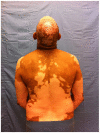Cellular stress and innate inflammation in organ-specific autoimmunity: lessons learned from vitiligo
- PMID: 26683142
- PMCID: PMC4685729
- DOI: 10.1111/imr.12369
Cellular stress and innate inflammation in organ-specific autoimmunity: lessons learned from vitiligo
Abstract
For decades, research in autoimmunity has focused primarily on immune contributions to disease. Yet recent studies report elevated levels of reactive oxygen species and abnormal activation of the unfolded protein response in cells targeted by autoimmunity, implicating cellular stress originating from the target tissue as a contributing factor. A better understanding of this contribution may help to answer important lingering questions in organ-specific autoimmunity, as to what factors initiate disease and what directs its tissue specificity. Vitiligo, an autoimmune disease of the skin, has been the focus of translational research for over 30 years, and both melanocyte stress and immune mechanisms have been thought to be mutually exclusive explanations for pathogenesis. Chemical-induced vitiligo is a unique clinical presentation that reflects the importance of environmental influences on autoimmunity, provides insight into a new paradigm linking cell stress to the immune response, and serves as a template for other autoimmune diseases. In this review, I will discuss the evidence for cell stress contributions to a number of autoimmune diseases, the questions that remain, and how vitiligo, an underappreciated example of organ-specific autoimmunity, helps to answer them.
Keywords: cellular stress; innate immunity; organ-specific autoimmunity; vitiligo.
© 2015 John Wiley & Sons A/S. Published by John Wiley & Sons Ltd.
Figures


References
-
- Committee TADC . In: Report to Congress: Progress in Autoimmune Diseases Research. NIAID N, editor. 2005.
-
- Cotsapas C, Hafler DA. Immune-mediated disease genetics: the shared basis of pathogenesis. Trends Immunol. 2013;34:22–26. - PubMed
-
- Akay BN, Bozkir M, Anadolu Y, Gullu S. Epidemiology of vitiligo, associated autoimmune diseases and audiological abnormalities: Ankara study of 80 patients in Turkey. J Eur Acad Dermatol Venereol. 2010;24:1144–1150. - PubMed
Publication types
MeSH terms
Substances
Grants and funding
LinkOut - more resources
Full Text Sources
Other Literature Sources
Medical

